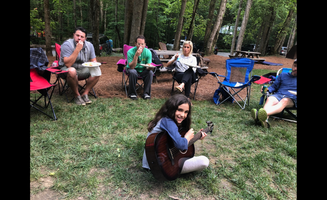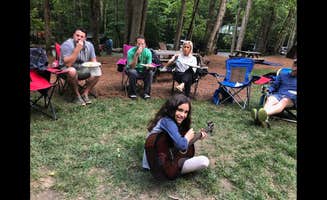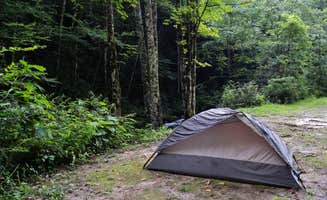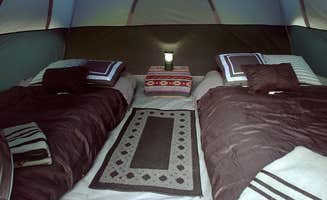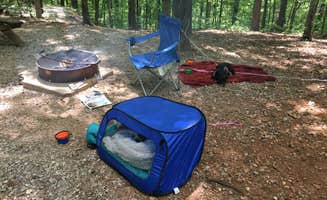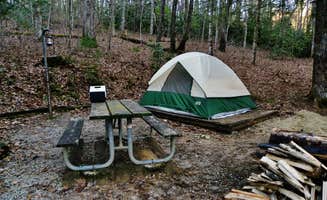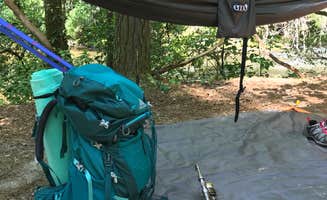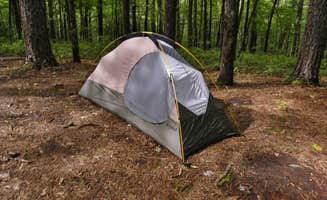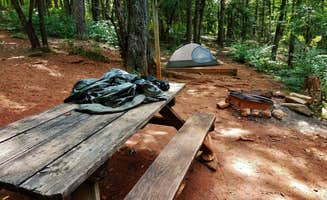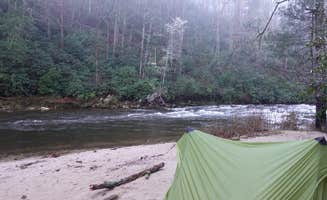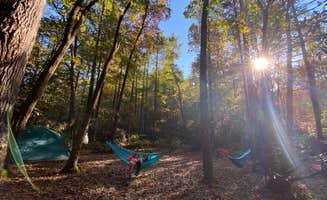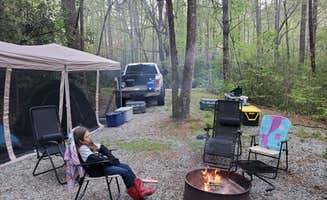Dispersed camping sites surround Lake Toxaway at elevations ranging from 2,600 to 3,500 feet, creating temperature variations that can drop 10-15 degrees cooler than lower elevations during summer months. The area sits within Pisgah National Forest's Grandfather Ranger District, characterized by dense mixed hardwood forests and numerous tributary streams. Winter camping requires preparation for temperatures frequently dropping below freezing, with occasional snow accumulation possible from November through March.
What to do
Waterfall hikes: Multiple waterfall trails start within 3-15 miles of Lake Toxaway tent camping areas. At Burrells Ford, "Short hike to King Creek Falls" provides a relatively accessible cascade experience. The trail crosses "a log footbridge" and requires navigating "a huge downed tree" that can be "slimy" after rain.
Trout fishing: Mountain streams in the area support healthy trout populations. At Burrells Ford, campers note it's "Good river access for trout fishing. Sites are right on the Chatooga River. This river is stocked with trout. Fishing license is required but both SC and GA are acceptable as the river is the state line."
Creek relaxation: Many sites provide direct stream access. At Blue Valley Dispersed Camping, campers appreciate the "gorgeous large creek" adjacent to sites. Another camper notes "every campsite we went to" had a "wonderful creek/river" nearby, creating natural cooling and ambient sound.
What campers like
Creek sounds: The rushing water creates natural white noise for sleeping. At Ammons Branch Campground, a reviewer noted the peaceful sounds: "The only sounds this time of year are the sounds of Ammons Branch and the wind."
Limited crowds: The remote locations reduce campground crowding compared to established campgrounds. At Jocassee Gorges Wildlife Management Area, a camper appreciated the solitude: "Fortunately for us the poor weather also scared off fellow campers so we ended up being the only ones in sight."
Natural swimming holes: Multiple creek-side sites offer swimming opportunities. At Blue Valley Dispersed Camping, "sites are right on the Chatooga River" with "great for swimming" areas noted by multiple reviewers. One camper praised the area's "clean and clear water like we haven't experienced before."
Trail connections: Many sites connect directly to hiking networks. The Foothills Trail connects multiple camping areas and provides extended hiking options. A Burrells Ford camper noted the campground connects to "lots of hiking, including the Foothills and Chattooga River trails."
What you should know
Access roads: Many camping areas require travel on unpaved forest roads. At Jones Gap State Park Campground, campers note that "to get to this campground, you have to travel curvy, mountain roads" and many sites require hiking from parking areas.
Bear presence: Active bear populations require proper food storage. Blue Valley campers should use the provided "high wire system for storing food, etc. from the animals" or bring bear canisters.
Site finding challenges: Some dispersed areas can be difficult to locate without clear directions. A Blue Valley camper reported: "Wrong directions. Never found this place but it's definitely not where the map brings you. Beware." Another advised "from Highlands, follow NC 28 south about 5.5 miles and turn right onto Blue Valley Rd. (S.R. 1618) at the sign."
Camping permit requirements: Some areas require permits during peak seasons. Jones Gap requires advance reservations for all sites, with a camper noting "This campground has 19 trail side sites that are all great and not far from the Middle Saluda River."
Tips for camping with families
Site selection: Choose sites with level tent pads and proximity to water for family enjoyment. At Cherryfield Creek Luxury Campsite, families appreciate being "steps away from moss covered waterfall" that provides natural entertainment for children.
Weather preparation: Pack for wide temperature swings, especially in spring and fall. One family camping at Burrells Ford experienced an unexpected cold snap: "It dropped to 17 degrees and our plan to stay in 2 tents quickly changed to everybody in the 4-man / 3-season tent that we had just purchased."
Gear transportation: Some sites require carrying equipment from parking areas. A Burrells Ford camper observed other families using creative solutions: "saw a Father and son taking there stuff down with a hand truck which is a very good idea. So you can either backpack it in or take a wagon to take your stuff in."
Kid-friendly activities: Shallow creek areas provide natural play spaces. A Jones Gap camper mentioned that sites feature "ample lawn space to play games" and "the rushing river and dense foliage with tons of mountain laurel makes the air seem so fresh."
Tips from RVers
Vehicle size limitations: Most dispersed camping areas cannot accommodate large RVs. At Ammons Branch Campground, "It is not a campground for large RVs. It is better suited for tents or small RVs." Sites typically can handle trailers under 20 feet.
Campsite approach: Forest roads often feature tight turns and limited passing areas. When accessing Blue Valley, campers note "the pavement will end in a half mile. Just stay on the main path for just little over 3 or so miles" but caution the roads are "very rough in some places and very narrow."
Leveling challenges: Many sites have uneven parking surfaces. At Jones Gap, a camper noted "The pad that has been cleared isn't perfectly level, but it's fine. There are however a few large buried rocks that keep it from being as smooth as you might expect."


